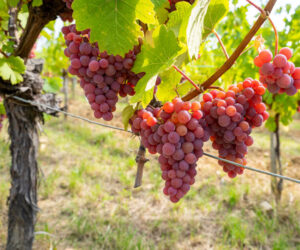Winemaking traditions have been passed down for as long as wine has been made, yet there are still a lot of regional traditions, techniques, and styles that have largely been overlooked worldwide. Traditional winemaking practices from the Old World can still be looked at as a source of inspiration for contemporary oenology worldwide, including home winemaking. One such example is the wines from Italy’s Valpolicella wine region.
Four different wines are often derived from a single vineyard in this region. The technique of drying the grapes and making passito wines (or straw wines) and the technique of ripasso will be described in more depth in this article. Obviously, the particular conditions that favor the development of these wines cannot be easily reproduced in many regions globally, but even if not fully adopted, these techniques could give useful hints to winemakers and contribute to understanding successful oenological products.
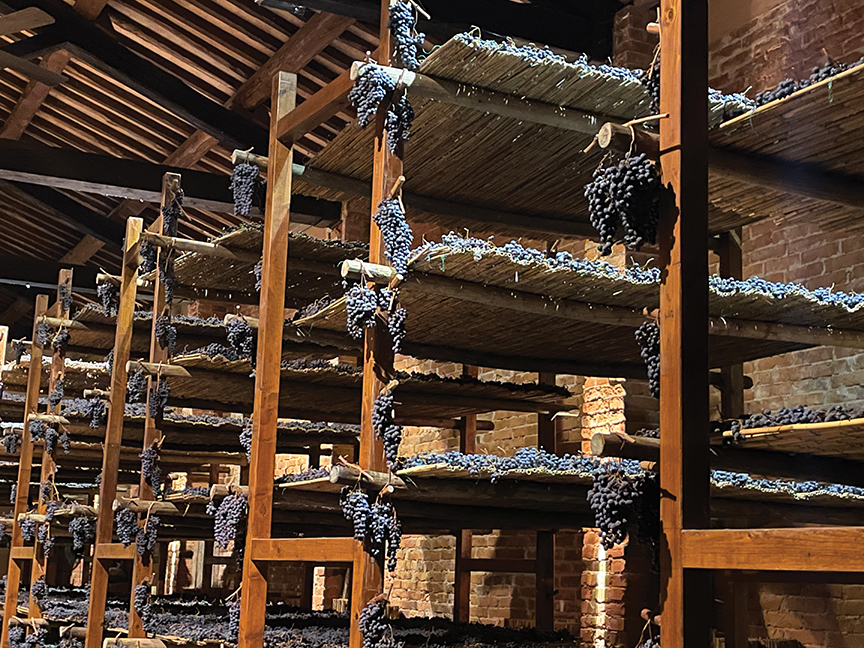
The Valpolicella Wine Zone
The mildly curved hills in the wine zone Valpolicella, in the northwestern Veneto region, host a landscape of vineyards mixed with cherries and olive trees. This wine zone stretches between the Garda Lake and the province of Vicenza, just north of the city of Verona.
Two internationally famous and prestigious red wines are grown here: the dry red wine Amarone della Valpolicella DOCG and the sweet red dessert wine Recioto della Valpolicella DOCG. DOCG means “controlled and guaranteed designation of origin”; it is usually the higher quality designation of origin of a wine by the Italian law.
Other red wines produced in this zone are Valpolicella Ripasso DOC and Valpolicella DOC, both being more affordable and easy-to-drink. DOC means “controlled designation of origin”; it is less stringent than DOCG, and usually implies a lower quality at a more affordable price.
The Valpolicella vineyards are protected northward by the Lessini Mountains and are mostly exposed southward. The climate is mild, a near-Mediterranean one, also for the proximity to Garda Lake, which mitigates both the lower temperatures in winter and the heat spikes in summer.
Vineyard elevation is limited, not higher than 1,650 feet (500 m). The rainfall fluctuates from 33–39 inches (850–1,000 mm) annually.
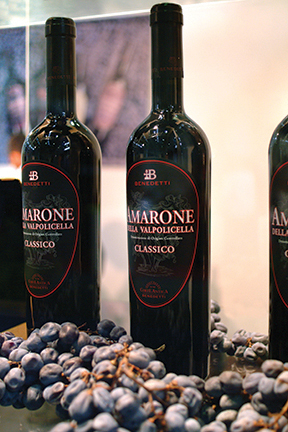
The territory in Valpolicella is formed by a fan of valleys departing from Verona, with varied geological origin. Three different kinds of soils are primarily found:
• Loam or clay limestone low soils at the bottom of valleys.
• Calcareous sandstone high soils on the ridges.
• Sloping marly soils mostly terraced.
Soil of volcanic origin can be found as well.
Three sub-zones can be distinguished in this region:
• To the west, the Classico sub-zone, which is the most regarded and traditional. Wines grown in this territory, where quality is considered to be the best, will often mention Classico on the label and usually have higher price points.
• Centrally, the sub-zone of Valpantena, a narrow valley of alluvial origin, connects Verona to the Lessini mountains. Wines from grapes grown in this region often mention Valpantena on the label.
• To the east is a recently added area, in part overlapping the Soave wine zone, towards the city of Vicenza.
The higher quality of the Classico sub-zone is thought to depend on the altitude (up to 2,000 feet/600 m), the better aspect of the vineyards, and the closeness to the lake. The sandy and extremely calcareous soils in the Classico sub-zone play a crucial role as well, because they allow for better water drainage, which is a noteworthy factor in the quality of the grapes. In addition to the sub-zone sometimes included on labels, another descriptor sometimes seen is Superiore, which indicates the wine has a higher alcohol content and has been aged for at least one year.
The four wines from Valpolicella share the same territory, the same varieties, and in most cases the same vineyards. Usually the bunches are selected during the harvest: The best grapes are picked for the more regarded wines (Amarone and Recioto), while the standard ones are used for Valpolicella or Valpolicella Ripasso.
Wine in Valpolicella is mostly produced by small family-run farms, where vintners grow and transform their grapes; frequently they also provide accommodation for tourists.
The Wine Grape Varieties in Valpolicella
The grape varieties used to produce these wines are: Corvina, the dominant grape (45–95% by law), Corvinone (or great Corvina), similar to Corvina, which can substitute the bunches of Corvina (up to 50%), and Rondinella (up to 30%).
Other red varieties can be involved, according to the law, at maximum usage of 15%; among these, an important role is played by the Bordeaux varieties, with which some vintners enrich their blend.
Corvina and Corvinone confer primarily a basic tannic structure, while Rondinella especially contributes to color. Corvina is medium-late maturing, perfectly in balance with the cool climate of the zone. It is mostly cultivated with the traditional pergola, a high-vines trellising system, which benefits from a better exposure to the sun and an increasing airflow through the foliage. At maturation, the Corvina grapes give the blend spicy notes (cinnamon, cloves) and aromas of red fruit (cherry and black cherry).
Amarone della Valpolicella DOCG
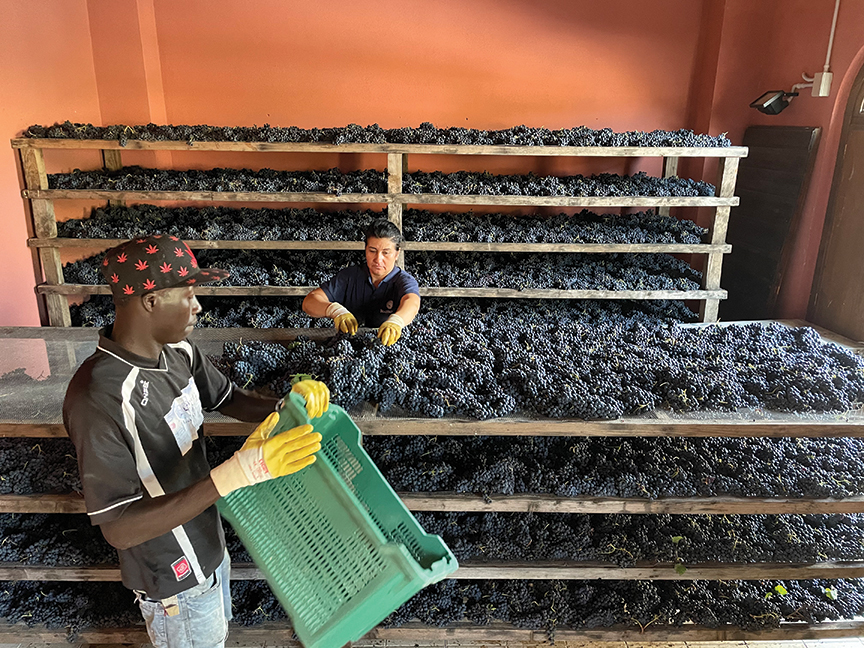
Amarone is a dry red passito wine. It was before the Second World War that the technique used for Recioto was modified in order to obtain Amarone: A dry wine, more alcoholic than Recioto and as complex as it can be due to the changes involved in the drying of the berries and the maturation
in barrels.
Some important points qualify the procedures to make this highly regarded and expensive wine:
• The yield must be less than 4.9 tons per acre (12 tons per hectare).
• The hand-picked bunches are selected in the vineyard.
• The grapes are dried for as long as 120 days; by law the fermentation cannot take place before December 1.
• The fermentation lasts very long, because the yeasts and the malolactic bacteria must overcome difficult conditions such as the high sugar content and the low temperatures (the months of December and January are the coldest of the year). For this reason, selected microbial cultures are usually necessary.
• The resulting wine, deep and bold, must be aged for at least two years in wood (four years in the case of Riserva); large oak barrels or French barriques are used.
The selection at harvest, usually during the first half of October, aims at collecting only the best bunches that have the berries not too close to each other, in order to favor air circulation. The drying period lasts from 60 to 120 days. The traditional method is very simple: The bunches are layered on straw beds in airy rooms, where mild temperatures in the range of 59–68 °F (15–20 °C) and low humidity are required. The use of special conditioning systems is permitted by the wine law.
The drying period modifies the characteristics of the grapes, in which water decreases (up to 50%), the sugar content increases, and the malic acid content decreases. Additionally, proteins undergo a partial hydrolysis and anaerobic chemical reactions produce new substances. These changes increase the complexity of the wine, improve structure, and produce new aromas and amino acids. The complete fermentation results in a wine of 14–16% ABV.
Amarone is a great wine for aging, but its fruity aromas, particularly cherry and black currant, and its supple tannins, guarantee great results in the first years of storage as well.
Recioto della Valpolicella DOCG
Recioto is a sweet red passito wine, boasting ancient tradition in this wine zone.
As to the process of winemaking, it follows the same course as Amarone: It uses the same varieties, same vineyards, as well as the same picking and drying method. The big difference is that the fermentation is stopped prior to the yeast consuming all of the sugars; resulting in a wine that is mildly sweet.
Valpolicella Ripasso DOC
This dry red wine falls somewhere between Amarone and Valpolicella wine, through a technique used to create it is very unique. It is a Valpolicella wine, made from the secondary grapes that are not selected for drying, but it benefits from the residual dried grapes coming from the maceration of Amarone or Recioto. To produce this wine, during winter, fermented pomace from batches of Amarone or Recioto is added to a standard Valpolicella wine for some days (ripasso means “using again”). This second fermentation adds phenolic substances and aromas that had been originated from the drying process. The Valpolicella Ripasso DOC is more concentrated and complex than the Valpolicella DOC.
Sales of this younger brother of Amarone have increased a lot in recent years, perhaps due to its compromise between high quality and affordable price.
Valpolicella DOC
This is a light, freshly acidic red wine for everyday consumption, to be drunk young. It is often compared to French Beaujolais, showing aromas of blueberry and sour cherry.
Make Passito Wine at Home
Let’s run through the steps home winemakers can take to make wines similar to Amarone or Recioto at home. From selecting grapes and drying them all the way through fermentation and wine maturation.
Varieties in North America that Might be Dried
Red varieties available in North America are suitable for drying if they are not susceptible to sour rot and are not tight clustered. For instance, Pinot Noir is susceptible to sour rot, however Cabernet Sauvignon, Merlot, and Zinfandel are all suited to the withering process.
Sour rot is a pre-harvest decay of the berries that tend to turn brown, soften, and eventually break down. It is of major concern for fruit and wine quality. The causes of sour rot are splits in the berry skin, often not visible, in the late period of ripening. Above all, any excess of rain prior to harvest causes berries to swell from the entrance of water. Then, the skin cracks under the pressure, especially in the case of varieties with tightly packed bunches. Insects like fruit flies, as well as various spoilage microorganisms like bacteria, yeasts, and fungi, penetrate the wounds. Ethanol produced by yeast is converted into acetic acid; the odor of vinegar is a diagnostic key to identifying the sour rot disease. Other berries are also affected because the juice can exit the berries and spread over the bunch. In the meantime, the odor of vinegar and the presence of sugars attract other insects. During bunch selection for drying it is crucial to sort out rotten bunches that smell of vinegar.
Selecting the Grapes
If you grow your own grapes then you can prune your vineyard for the purpose of making passito wines. In order to lower the productivity and improve quality, thinning of the bunches is advisable prior to harvest. At harvest, only the best bunches that will be dried should be selected and hand-picked in order to make passito wines. Any bunches that have damaged and rotten grapes, and those with apparent fungal attacks, should be left out. The remaining bunches that are not selected are destined to more ordinary red wine, better suited for early consumption.
The bunches destined to drying should be sound and loosely packed. As they are sorted and spread in a single layer to improve air flow, a check and removal of the rotten bunches should be repeated also at this stage. The berries should be perfectly ripe, with mature tannins, capable of the transformations that are expected during the dehydration.
Drying the Grapes
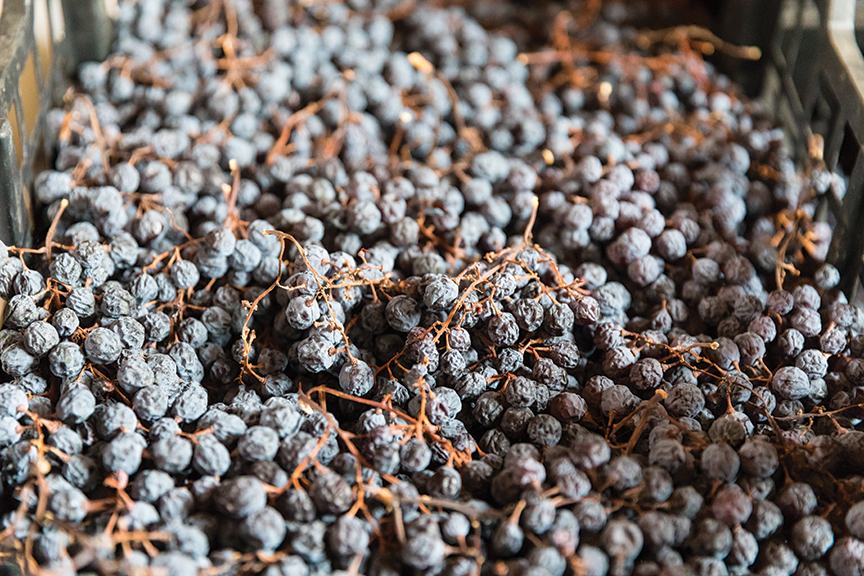
The skin of the grapes is made of an external epidermis plus six to ten layers of cells. The epidermis is covered with the cuticle, a non-living layer; an outer layer of wax protects against fungal pathogens and mechanical injuries. During the drying period, water is partially lost through the berries’ skin due to an increase of heat while the sugar content increases due to the loss of water.
The terms withering, dehydration, raisining, and drying are used to name similar processes. The water loss is the common trait of a series of methods, which can have different purposes: The production of raisins for table consumption, the winemaking of dessert passito wines or dry passito wines, or the second fermentation of a wine with withered grapes.
There are actually a few drying methods that can be used by home winemakers. The first option is to allow the drying to be done on-vine (late-harvest). If you go this route, the picking is postponed after ripening in order to let the bunches wither during fall. When the desired water loss is reached, the bunches are picked and pressed.
A second, off-vine method, involves grapes being harvested at maturation and then drying the bunches in the sun prior to destemming and pressing. This traditional off-vine drying method, typical of warm or hot climates is still widely adopted in Mediterranean countries — in particular Greece, Italy, and Spain. The berries or the bunches are laid on sheets in a thin layer over the ground and directly exposed to sunlight. It is a rapid way of drying, suitable for the production of raisins. Temperature rises greatly, and water loss is fast. The color of the berries can be partially deteriorated due to the sun exposure. When this method is used to make passito sweet wines, the varietal aromatic compounds can be easily oxidized and lost. Only the aromas of honey, dried figs, and dried apricots are usually perceived in the resulting dessert wine.
The most suitable method for making quality passito wine is shade drying — the method adopted in Valpolicella. It is a natural off-vine method under controlled conditions, in which the ambient air is the main source of the required heat. The amount of heat is limited, so the process is slow (2–3 months), and the color of the berries is conserved. The bunches are dried in ventilated closed facilities, where they are thin-layered horizontally on plastic boxes, wooden or wire shelves, or canes.
This method requires particular environmental conditions: Low humidity and temperatures from 59–68 °F (15 and 20 °C). Rainy and cold climates during fall do not lend themselves to this method. These conditions allow a long dehydration process in which water loss is accompanied by the berry senescence stress. The low temperatures are crucial to obtain this stress: The death of the berry cells is delayed, and some metabolic changes take place. In particular, anaerobic fermentation and amino acids catabolism occur. The evolution of the tannins is often reached, improving the flavor of the wine. New aromas are formed, and the varietal aromatic substances, such as the terpenes, are preserved. The wine quality is enhanced due to the increase of its complexity.
During the dehydration, attention must be paid to avoid the onset of sour rot. Any bunches that are damaged should be removed.
When the water loss has reached 20–30% of the initial mass, the grapes are destemmed and crushed.
Fermentation
After crushing, the must is fermented. The added yeast cultures should be suitable for fermentation in difficult conditions because the sugar level is high, usually more than 27%. The yeasts should also produce low levels of acetic acid and ferment to a high alcohol content (at least 18%). The ability to ferment at low temperatures could be important as well. A couple of recommendations available to home winemakers are Lalvin EC1118 and Red Star Premier Blanc.
The fermentation lasts 1–2 months. To make a sweet passito wine the yeast activity should be stopped early, so as to keep an adequate level of residual sugar. If the fermentation is prolonged, the wine will end up dry, requiring the winemaker to change the type of wine they make or resort to backsweetening.
Wine Maturation
The passito wine can be consumed early, or can be aged in wooden containers that improve the sensory profile. The maturation of Amarone wine is generally carried out in big oak barrels in order to limit the contribution of wood-to-wine aroma.
During aging, wine aroma is modified by various chemical reactions depending on wine composition and on environmental conditions. Tasting reports of young wines of Amarone often describe cherry and spicy aromas, while balsamic and tobacco notes are commonly associated with the aged wines.
The Ripasso Technique
The leftover fermented pomace from the dried grapes can be added to another wine, for instance the ordinary wine that has been made from the bunches that were not selected in the passito wine production. This addition causes a second fermentation, due to the yeasts still present in the pomace. The skins release tannins and aromas.
The ripasso method gives the wine softer acidity and greater complexity and structure. It also makes the wine suitable for aging in barrels for
some months.
Bringing this all home for amateur winemakers — there are a lot of unique winemaking techniques used by winemakers in Valpolicella that we can learn from. Whether looking for new flavor and aroma combinations from the grapes in your backyard vineyard or just looking to try something new next harvest, there is merit to these Old World techniques that are still used today.
A Case Study of Making Amarone (Sidebar)
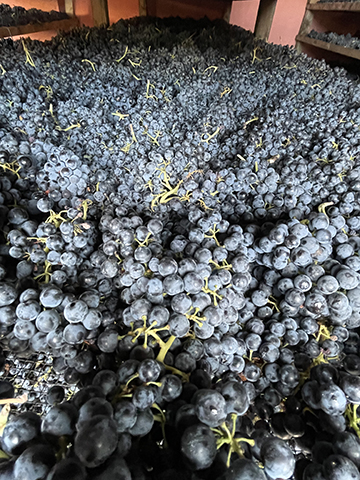
In order to better specify the procedure for making a dry passito wine, an example from a case study on Amarone della Valpolicella is detailed as follows:
1. Harvest happens in the second half of September. At this point the sugar content of the grapes is from 17–18 °Brix and the acidity is 6.3–6.9 g/L.
2. Sound bunches, without wounds or fungal attacks, were picked, carefully combed through, and then placed in the withering facilities for the dehydration.
3. In winter, when water loss reached about 30%, the grapes were layered on sorting tables in order to leave rotten berries out. Then they were destemmed and crushed.
4. Sulfur dioxide was added at a rate of 5 g/hL (0.05 g/L).
5. Commercial yeasts (carefully selected for difficult fermentation conditions) were added and fermentation started in stainless steel containers. The must temperature was controlled between 77–86 °F (25–30 °C) throughout fermentation.
6. Malolactic bacteria were also added after the first day of fermentation. Two daily punchdowns of the cap improved the maceration.
7. The fermentation was stopped at a residual sugar level between 3.5 and 7.0 g/L (dry wine).
8. The pomace was pressed, and the pressed wine was added to the free run wine.
9. After a second addition of sulfites (2–4 g/hL SO2, or 0.02–0.04 g/L), the wine was moved to glass containers and left at low temperatures for tartaric stabilization.
10. After filtering, the wine was bottled in mid-January.
REFERENCES:
• Barata A., Malfeito-Ferreira M., Louriero V., 2012. Changes in sour rotten grape berry microbiota during ripening and wine fermentation. Int. Journal of Food Microbiology, vol. 154.
• Barata A., Malfeito-Ferreira M., Louriero V., 2012. The microbial ecology of wine grape berries. Int. Journal of Food Microbiology, vol. 153.
• Bellincontro A. et al., 2016. Management of post-harvest grape withering to optimize the aroma of the final wine: A case study on Amarone. Food Chemistry, vol. 213.
• D’Onofrio C., Bellincontro A., Accordini D., Mencarelli F., 2019. Malic Acid as a Potential Marker for the Aroma Compounds of Amarone Winegrape Varieties in Withering, American Journal of Enology and Viticulture, vol. 70.
• Dall’Asta C., Cirlini M., Morini E., Galaverna G., 2011. Brand-dependent volatile fingerprint of Italian wines from Valpolicella. Journal of Chromatography 1218:7557-7565.
• Mencarelli F., Bellincontro A., 2020. Recent advances in post-harvest technology of the wine grape to improve the wine aroma. Journal of the Science of Food and Agriculture, vol. 100.
• Paronetto L., Dellaglio F., 2011. Chapter 9 – Amarone: A Modern Wine Coming from an Ancient Production Technology. Advances in Food and Nutrition Research, Vol. 63.
• Pérez-Coello M.S., Diaz-Maroto M.C., 2009. Volatile compounds and wine aging. Wine chemistry and biochemistry a cura di M.V. Moreno-Arribas e M.C. Polo. Springer, pp.295-311.
• Slaghenaufi D., Peruch E., De Cosmi M., Nouvelet L., Ugliano M., 2021. Volatile and phenolic composition of monovarietal red wines of Valpolicella appellations. OENO One vol. 55, n.1.
• Wang J. et al., 2016. Grape drying: current status and future trends (ch. 7). Grape and Wine Biotechnology, ed. by A. Morata and I. Loira.



